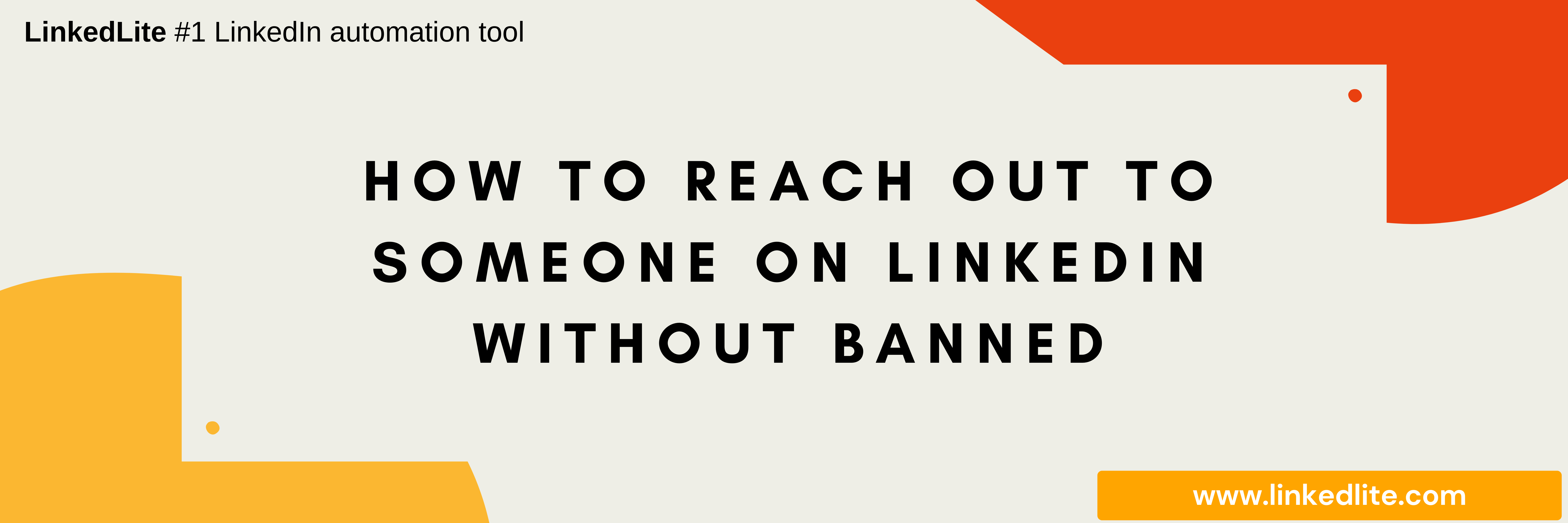
Wondering how to follow through with your LinkedIn outreach campaigns safely? Connect with 50 people daily without being concerned about your account? Or just looking for the best LinkedIn outreach safety practices?
This article is right what you need.
When it comes to LinkedIn outreach and automation, safety is a must.
Because, the thing is if you’re connecting with 50+ people per day, sending them the same spammy, boring outreach request message and no one is replying, well, your account might be in danger.
If you’re doing a lot of outreach on LinkedIn, you need to think about the safety of your account.
The most common reasons as to why your LinkedIn account might seem suspicious or even be restricted are the following:
- Too many connection requests (especially if they’re automated).
- Low acceptance rate.
- Use of dangerous LinkedIn automation tools.
- Inappropriate, illegal, or spammy activity coming from the account (e.g. unusually high profile views, messages, etc. Usually through automation).
- No replies to your messages.
Worry not though. By the end of this guide, you’ll know how to reach out to your leads on LinkedIn without the fear of getting your account restricted. We’ll also show you how to use automation safely.
Here’s what we’ll cover:
- 6 Top Ways to Expand Your LinkedIn Contact List
- 5 Best LinkedIn Outreach Practices That Don’t Get Your Account Restricted
The first thing you need to know is the different LinkedIn outreach connections. Then we’ll talk about how to utilize each of them safely and most efficiently.
5 Top Ways to Expand Your LinkedIn Contact List
There are different ways you can grow your LinkedIn network.
But most people stick to the same few outreach features.
Let’s take a look at all of them first and see when you can use them.
1. Sending a connection request
You simply go to your target’s LinkedIn profile and hit that familiar Connect button.

In the box, you write a short message on how you know them or why you’d like to connect.
When sending connection requests, you have to think about your relations with those people.
Do you know them? Do you have something to offer? What will they gain from connecting with you?
For example, if I were to do a quick search for online marketers and people working in the information technology and services industries near me, this is what it’d look like:
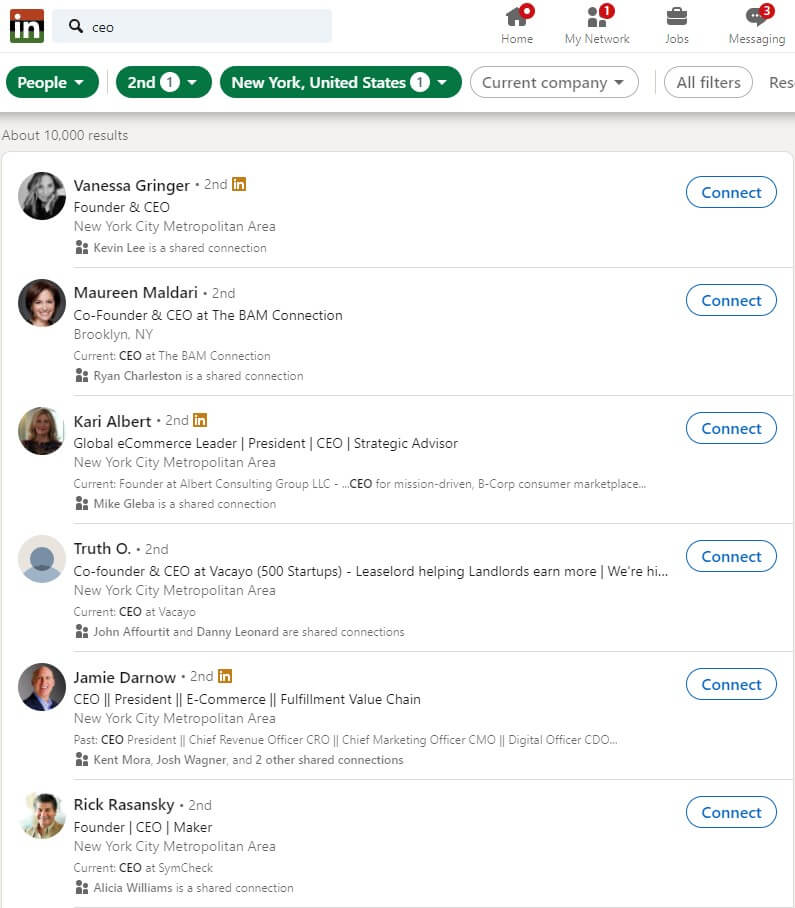
We always recommend giving value upfront when sending a connection request to your ideal target market person.
We ran a few different outreach campaigns with that in mind (giving value) and got up to a 50% connection request acceptance rate. Here’s one of the different templates we experimented with for outreach:
“Hi {first_name}, I’m Demi – a Growth Marketer. But I know that’s boring & doesn’t concern you.
So how about I send you a kickass guide on how we drove 1,500 paid customers from LinkedIn in just 4 months?
Click accept if you’re interested. Or you’ll never hear from me again!”
Check out our full guide on the best 10+ LinkedIn connection message templates for more examples you can use now.
2. Advanced use of LinkedIn boolean searches
The more specific your LinkedIn cold message and target audience is, usually the higher your reply rate is.
Running an advanced LinkedIn search using boolean operators can let you reach leads you might not have access to otherwise.
Boolean search is a type of advanced search that allows you to combine keywords with operators (or modifiers) such as AND, NOT, OR to produce more relevant LinkedIn results.
Here’s how that works:
- AND
- NOT
- OR

3. Import an address book
This is ideal if you’re just starting on LinkedIn or just want to connect with people you may already know.
If you haven’t done this by now, it might be worth a shot as it takes less than a minute and can be a great way to boost your connections.
Importing and syncing your mobile address book helps LinkedIn identify people you know who are already using LinkedIn. It’s the quickest and safest way to connect with your professional contacts.
To import an address book on LinkedIn and sync your contacts: Tap your profile picture, click Settings & Privacy under the Account section.
Then, select Account Preferences and Syncing Options.
Once you get there, you can sync contacts from your phone contacts or calendar.
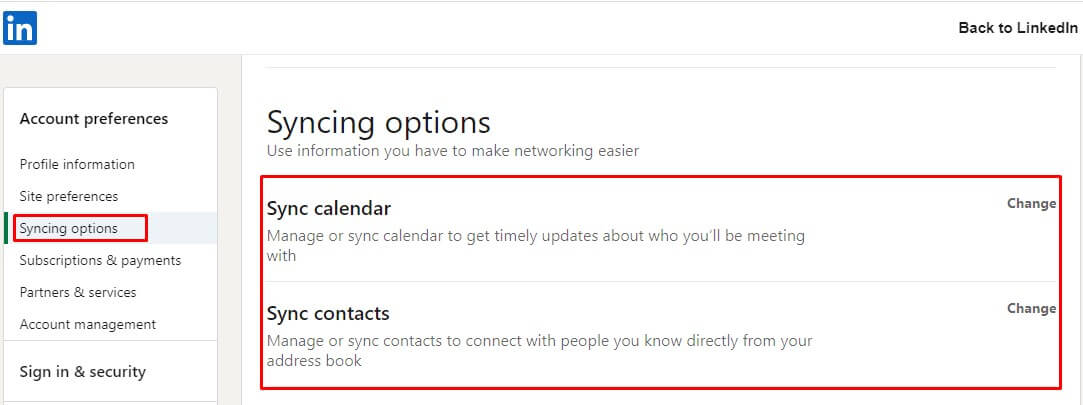
From there, you can sync calendar or contacts.
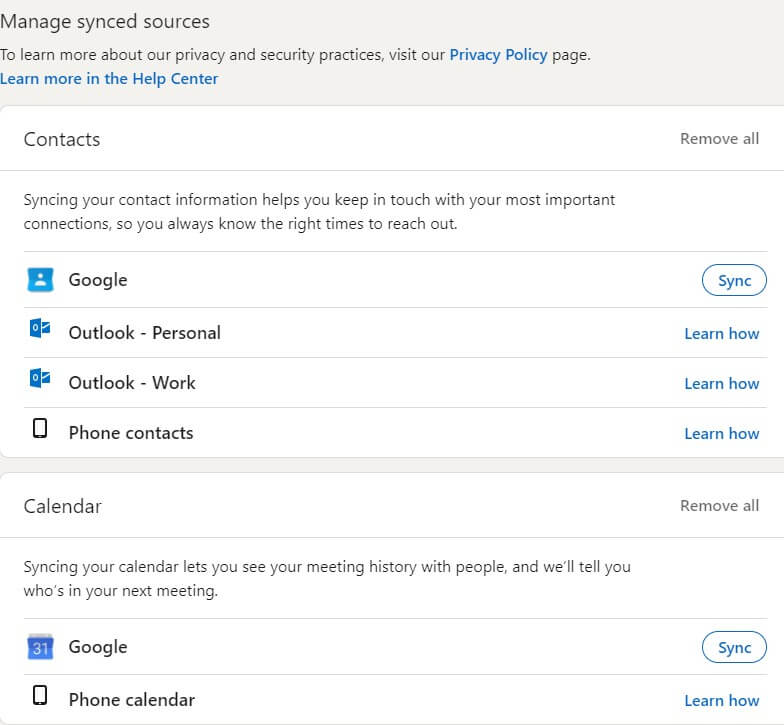
Doing so will connect you mostly with people you already know in real life. So, expect most of them to accept your request.
4. Import contacts
Here’s another simple way to connect with people you may already own if you have not done so yet.
Simply go to My Network on the left sidebar and select Continue to see if there’s an option to import your contact list.
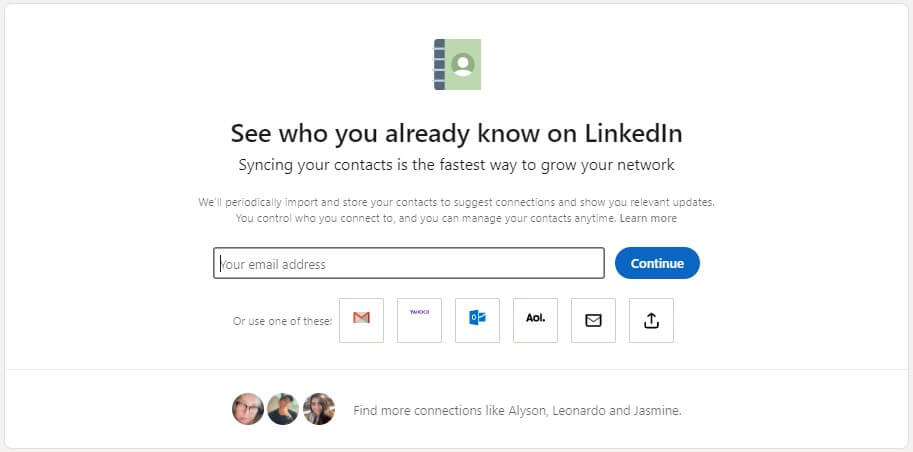
5. Use LinkedIn recommendations list
LinkedIn gives a few different recommendations when you want to connect with relevant people.
Ideally, your profile should be fully optimized. So, the more LinkedIn knows about you – the more relevant the suggestions here will be.
Check out our 5 essential steps to prepare before launching an automated LinkedIn outreach campaign to learn how to optimize your LinkedIn profile and other tips you should keep in mind.
Then, go to My Network to find:
- People you may know from your university/school (if your profile is filled in).
- People you may know with similar roles.
- People you may know from mutual LinkedIn groups.
- People who are in the same industry.
- And finally – more suggestions for you based on mutual connections.
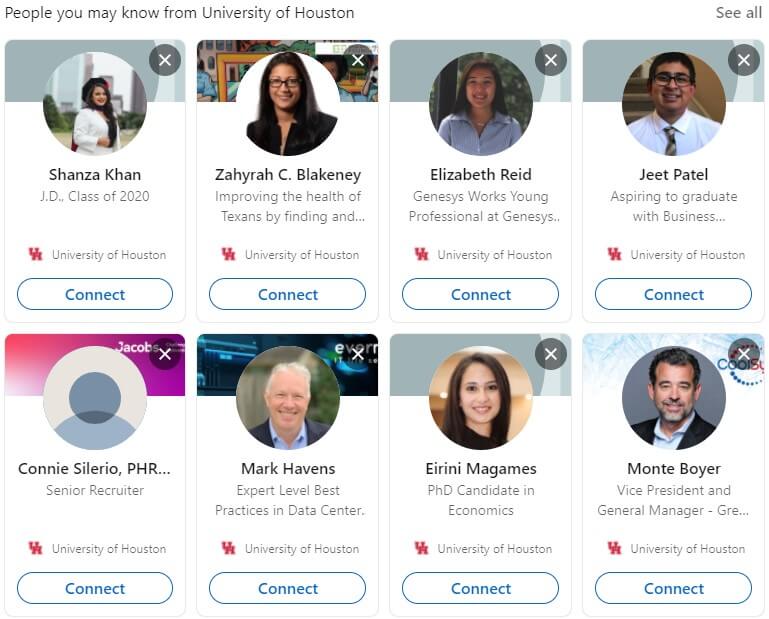
This is a great ‘quality over quantity’ approach as you’ll likely get to connect with fellow professionals and relevant people in your niche.
Thankfully, LinkedIn will do the hard work for you and present you with all the leads
All you have to do is write a meaningful connection request.
Keep on reading for our top LinkedIn cold outreach messages that get replies and other templates you can copy today.
6. Join LinkedIn groups strategically
LinkedIn groups are a great way to expand your network strategically.
Join groups focused on topics relevant to your niche and you’ll be more likely to find your target audience there, engaging with each other and sharing relevant content.
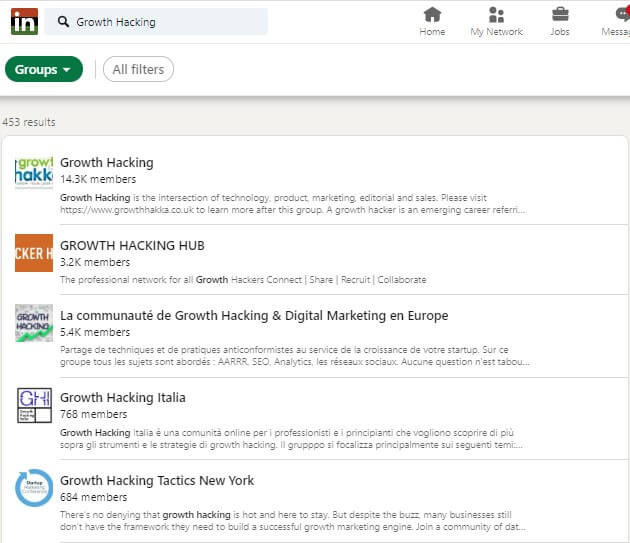
You can find groups with anywhere from 500-100,000+ members.
So, if you want to get noticed, you can start with smaller groups and work your way up.
This is also a great way to study your target audience.
Join their groups, read their content, ask questions, and you’ll learn what they engage with more.
Once you become familiar with a few faces, you can send a connection request accordingly.
It takes time to get to know people, but LinkedIn groups make it easy for you by collecting together like-minded people.
Though, probably the best thing about LinkedIn groups is that you can message anyone in them without being connected. And LinkedIn will treat this as a regular 2nd connection message.
So, there will be fewer restrictions.
Simply go to the full list of members, find the person you want to reach out to, and click Message.
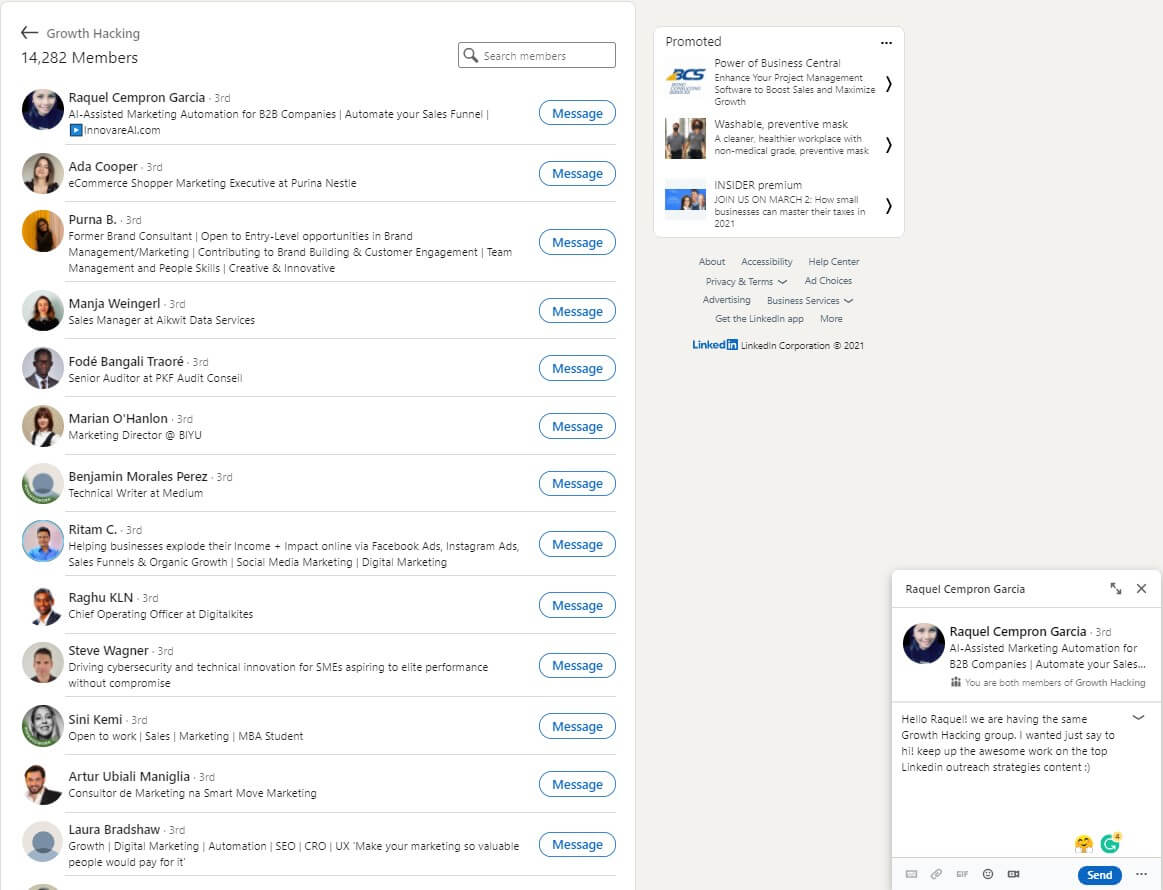
Now, finding your target market on LinkedIn is half the battle.
The other half is knowing what’s the best way to reach out to them, with all the best LinkedIn safety practices in mind so that your account doesn’t get restricted.
5 Best LinkedIn Outreach Practices That Don’t Get Your Account Restricted
We’ve covered LinkedIn safety quite extensively on our blog before.
If your LinkedIn account is already restricted, check out our guide on what to do and 7 safety tips to keep in mind.
If that’s not the case though, here are some of the best LinkedIn outreach practices you should follow anyway.
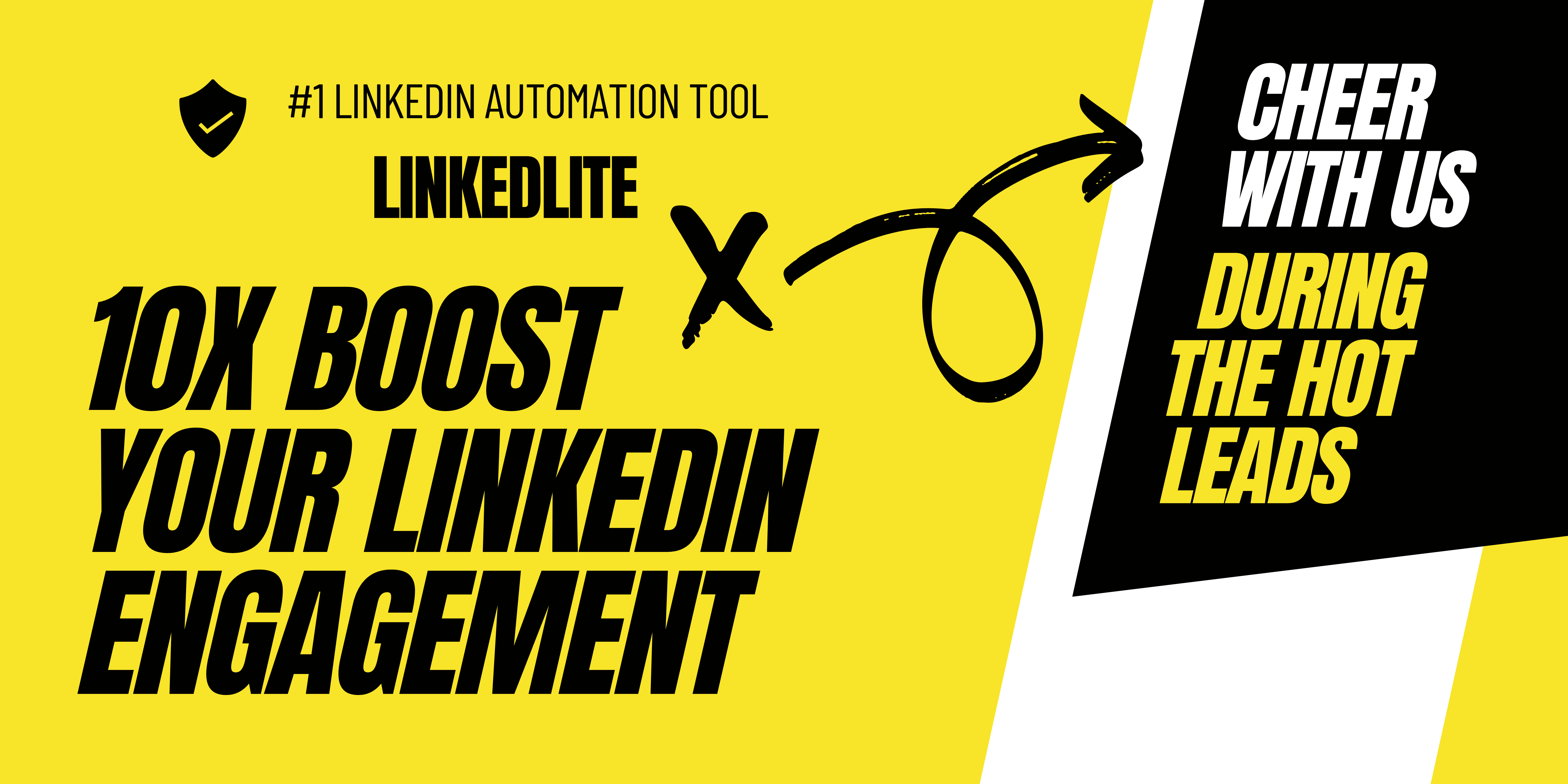
1. Use personalization
Personalization is an essential part of LinkedIn outreach.
For safety reasons as well as engagement.
If you use it well, you’ll have more people willing to connect with you and reply.
And the reason why this is great for safety is that the more high-quality, organic engagement and connections you have, the fewer problems LinkedIn have with your account.
As human beings, we react positively to compliments and specific comments.
So, if you want your leads to connect with you and reply, you better show that you care.
Through personalization, you show that you took the time to research them and found something relevant. Rather than giving generic comments about how you love their content (which is what most people do).
Which of these outreach examples sound better?
- “Hi, Loved your latest article on LinkedIn growth-hacking. I write similar B2B marketing posts too. Glad to connect.”
- “Hi, Read your Top 3 LinkedIn Outreach Strategies ebook and liked your post engagement outreach strategy. I have a few questions about it if you don’t mind helping me out on this. Can’t wait to try it out.”
The second one is more engaging, specific, and even gives the person a reason to reply.
Most people love to help. So, if you give them a compliment and stroke their ego a bit, they’ll be guaranteed to connect with you.

2. Use the right cold message template
Not sure what to write in your LinkedIn cold outreach messages?
No problem!
Just use our templates.
We’ve tried and tested many different LinkedIn cold outreach campaigns. With various growth hacks, templates we A/B tested, and more.
Now, a lot of your LinkedIn cold messaging results will highly depend on your outreach campaign type.
This is why we gathered our top 15+ LinkedIn cold messages that get a ~49% reply rate and divided them based on different campaigns and strategies.
Check out the article for cold messages and templates you can start using today that will boost your reply rate.
PS – My favorite outreach approach is giving value upfront. Check out the guide (see the link above) on how to make sure you’re targeting the right people with the right templates.
3. Plan out your campaigns
As mentioned above, half of the outreach is making sure you’re targeting the right people. For this, you should also have your LinkedIn campaign objectives and goals defined.
Giving value upfront is nice. However, the main objective is still to book a call.
So, your campaign structure and follow-ups might look something like the following:
- Connect
- Give value and earn your leads’ trust.
- Engage and remove any doubts.
- See if you can help and how (qualifying leads).
- Book a call.
We did something like this in the past.
By using an omnichannel outreach with hyper-personalization, we were able to engage with our leads on different platforms, give value, and qualify if they’re ready for a call.
- We created an irresistible offer for our target market (Top 3 LinkedIn Outreach Strategies PDF).
- Made a post about it on LinkedIn telling people to comment if they wanted to receive it.
- Endorsed the post via post engagement to increase its views, reach, comments and awareness.
- Created a LinkedIn outreach campaign on LinkedLite.
- Created two email outreach campaigns on Lemlist (one with the PDF offer and a follow-up).
- Created webhooks on Zapier to connect everything.
This campaign has everything – an offer, personalization, best outreach safety practices, and even an omnichannel approach.
By getting people to comment on our post and engage with it, they become more familiar with our brand and earn our trust. Then, when we reach out to them by email, they already know what to expect and most of them are glad to engage after.
Though this is a bit longer than most growth hacks we’ve covered, it’s well worth it because of the results.

Check out the full LinkedIn omnichannel outreach growth hack here.
4. Consider Sales Navigator to reach more specific leads
The more specific your outreach list is – the better the results are.
And as a cherry on top, LinkedIn will be glad you’re using Sales Navigator and in most cases, won’t think you’re sending spammy and low-quality messages.
If you’re not aware by now, LinkedIn Sales Navigator is the premium version of LinkedIn. It costs $64.99/month and allows you to find leads more efficiently.
If you’ve been using the regular version of LinkedIn for some time now and know you’re way around its advanced search (using boolean operators, as covered above), then Sales Navigator might be worth it.
With it, you can start using some modern search tactics and target people by:
- Using job change alerts.
- Attracting inbound leads.
- Using advanced LinkedIn group filtering.
- Searching for prospects similar to your existing customers.
- Saving your searches, looking for leads using the “posted on LinkedIn” filter, combining it with automation to reach your leads on autopilot, and more...
Though, probably one of the best things about LinkedIn Sales Navigator is that you can combine it with LinkedIn automation for some serious results.
5. Use the right LinkedIn automation tool that won’t get your account restricted
At this point, you probably have your LinkedIn profile fully optimized, connected with fellow industry experts in your niche, and know your way around outreach.
To speed things up, however, you can also use LinkedIn automation to set the above growth hacks on autopilot.
This way, you can have LinkedIn doing all the manual outreach steps in the background while you work on other tasks.
Now, I won’t bore you with all the technical details, one thing that’s important here is the safety of your LinkedIn account.
- LinkedIn cloud-based tools
- LinkedIn browser extensions
We recommend using the #1 LinkedIn automation tool.
Conclusion
So, to recap, LinkedIn can be a goldmine for lead prospecting. But if you’re not careful, you can have your account suspended if you’re sending low-quality, spammy, and sales-y messages no one is responding to.
To make the best of your LinkedIn outreach campaigns, be sure to keep the above best safety practices in mind.
